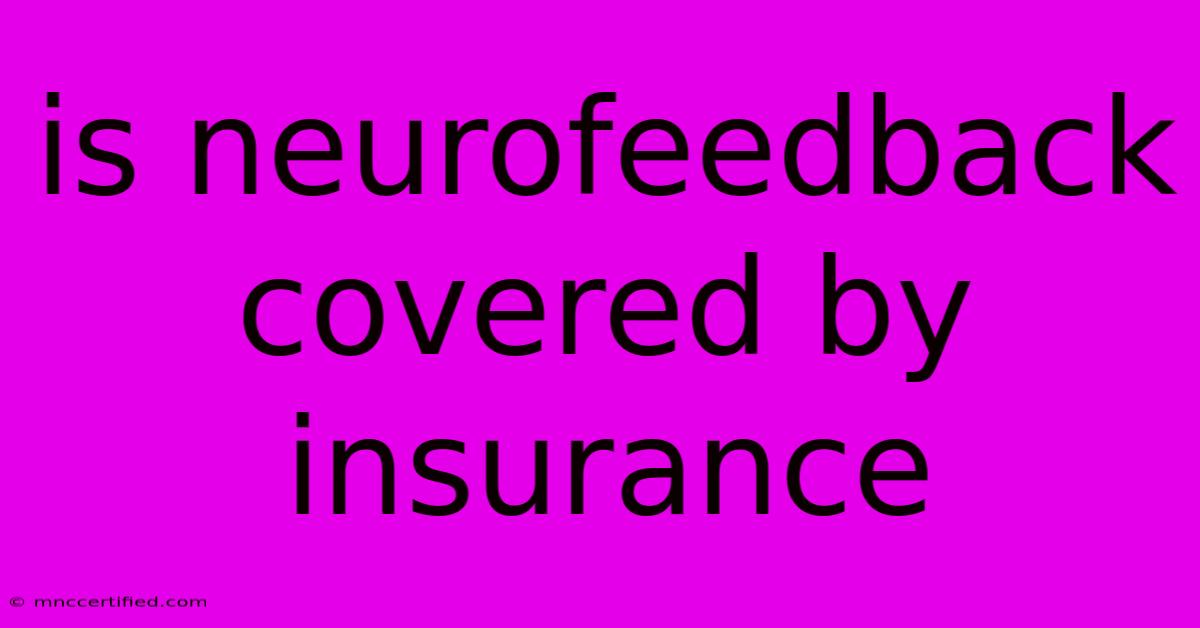Is Neurofeedback Covered By Insurance

Table of Contents
Is Neurofeedback Covered by Insurance? A Comprehensive Guide
Neurofeedback, a type of biofeedback that trains your brain to function more optimally, has gained traction as a potential treatment for a range of conditions. But a common question arises: is neurofeedback covered by insurance? The answer, unfortunately, is not straightforward.
Understanding Insurance Coverage for Neurofeedback
Insurance coverage for neurofeedback varies greatly depending on:
- Your insurance plan: Different insurance companies and plans have varying policies regarding alternative therapies like neurofeedback.
- Your diagnosis: Some insurance providers may cover neurofeedback for specific conditions like ADHD, anxiety, or depression, while others may not.
- Your location: Coverage policies can differ based on state and regional regulations.
- The neurofeedback practitioner: Some providers may be in-network with your insurance plan, while others may not.
Factors Affecting Coverage
Here are some crucial factors influencing whether your insurance will cover neurofeedback:
1. Medical Necessity: Insurance companies typically require proof of medical necessity to cover any treatment. For neurofeedback, this often involves a diagnosis from a qualified healthcare professional, such as a psychiatrist or psychologist.
2. Clinical Evidence: The growing body of research supporting neurofeedback's efficacy plays a role. Insurance companies prefer treatments backed by robust clinical studies, which is an area where neurofeedback research is continually expanding.
3. Prior Authorization: Even if your plan covers neurofeedback, you may need prior authorization from your insurance company before starting treatment. This involves submitting documentation and receiving approval.
4. In-Network Providers: Choosing a neurofeedback practitioner in-network with your insurance plan can significantly increase the chances of coverage.
How to Determine Coverage
1. Contact your insurance provider: The most reliable way to know if your plan covers neurofeedback is to directly contact your insurance company. They can provide specific information regarding your policy and coverage for neurofeedback.
2. Ask your neurofeedback practitioner: Experienced practitioners are often familiar with insurance coverage and can guide you. They may have information on plans they commonly work with or can help you navigate the process.
3. Check your benefits online: Some insurance companies allow you to access your benefits online through their website or mobile app. This can provide information about coverage for specific treatments.
Strategies to Improve Your Chances of Coverage
- Get a diagnosis: Ensure you have a clear diagnosis from a licensed healthcare professional for the condition you seek treatment for.
- Seek in-network providers: Choose a neurofeedback practitioner in-network with your insurance plan.
- Gather documentation: Prepare medical records and documentation to support the medical necessity of neurofeedback for your condition.
- Contact your insurance company: Communicate with your insurer to understand their coverage policies and procedures for neurofeedback.
- Consider alternative payment options: If insurance coverage isn't available, explore out-of-pocket payment options or health savings accounts (HSAs).
Conclusion
While insurance coverage for neurofeedback can be unpredictable, understanding the factors involved, taking proactive steps, and being informed about your specific plan can increase your chances of obtaining coverage. Remember, persistent communication with your insurance provider and neurofeedback practitioner is key to navigating the process successfully.

Thank you for visiting our website wich cover about Is Neurofeedback Covered By Insurance. We hope the information provided has been useful to you. Feel free to contact us if you have any questions or need further assistance. See you next time and dont miss to bookmark.
Featured Posts
-
Farm Bureau Insurance Chipley Florida
Nov 10, 2024
-
Wta Finals Gauff Triumphs Over Zheng
Nov 10, 2024
-
A Cats Guide To Bonding With Dragons
Nov 10, 2024
-
Car Insurance Templates Free Download
Nov 10, 2024
-
Surebridge Insurance Customer Service
Nov 10, 2024